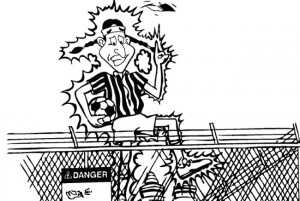Hamhawk Hazard has to go: fire chief

By Sharon Weatherall
BEAUSOLEIL FN – The First Nation chief and his community’s fire chief agree that Hamhawk Hazard has to go.
“It is demeaning and stereotyping to portray a First Nations person to be very unintelligent,” says Chief Roly Monague, commenting on a controversial cartoon character being used to teach safety to children in materials that were approved by Ontario First Nations Technical Services Corporation (OFNTSC). “Little kids will be reading this and we have been stereotyped enough in our lives. This kind of stuff in this day and age is not well received.”
Chief and council support the stance of Fire Chief Allan J. Manitowabi – who says the caricature has no cultural significance – and have asked OFNTSC to have the Hamhawk Hazard name and character changed.
“I was shocked and surprised to see this material had been sent out to Tribal Councils,” says Manitowabi, who began his fight to change the depiction after he first saw it in an electrical booklet that was published in 2010. “At the time I inquired by phone to see where this had come from and found it had been OFNTSC approved.”
The OFNTSC Fire Program provides First Nation Fire Prevention Officers with technical advisory services for fire prevention, code interpretation, emergency service vehicles, and community fire prevention issues. Manitowabi says the corporation has overseen the creation and distribution of numerous fire prevention materials and brochures using Hamhawk Hazard without consultation and approval by First Nations fire services personnel.
“Speaking with Elders from our community, they feel the material is scary for kids and is putting constraints on how we see ourselves,” says the fire chief. “They say the picture is derived from negative portrayals through caricature and is misleading of the culture of First Nations – it presents flawed imagery of Native people.”
Community Elders say if the materials were produced using provincial and/or government funds, there is a clause in the use of federal funds that stipulates those resources are not to be used to promote prejudice, racism, stereotyping or any kind of put-down from one group to another groups based on race, colour, creed, or culture.
In November, 2011 the First Nation’s Chief & Council sent a letter of concern about the Hamhawk Hazard booklet.
The following month OFNTSC Executive Director Bob Howsam responded, saying the booklet would be examined and changes made.
At the same time there was never any response from the President of ONFFS and it executive board on this issue.
In a recent interview, Howsam confirmed that his office is aware of Fire Chief Manitowabi’s concerns, noting that the electrical booklet – which is part of a series of booklets on First Nation children’s safety – “is no longer active”. He said it will not be reprinted, but other booklets in the Hamhawk Hazard campaign will continue to be handed out to First Nation communities who request materials.
“The whole series has been generally well-received,” said Howsam.
Manitowabi says Howsam – former Regional Director General, Ontario South for Indian and Northern Affairs Canada, and the OFNTSC board approved the Hamhawk character. Because the booklet had the Hydro One logo on it, Manitowabi contacted Hydro One and learned it was similar to a book they use for educational material with a character named “Harry Hazard”, which was changed to Hamhawk Hazard in booklets distributed to First Nations Fire Services. The booklets were printed by MTS Native Services, Ohsweken Ontario.
According to Howsam, Ontario First Nations Fire Services were involved in the process that chose the Hamhawk Hazard campaign to produce materials that school-aged First Nation children could identify with. Howsam said Hydro One had no role in the Hamhawk campaign, which did receive financial support from Indian and Northern Affairs Canada, although he was unsure of the amount of the INAC contribution.
The bigger issue, for Manitowabi, is that OFNTSC did not have a mandate to conduct this campaign. He said many First Nation fire services are afraid to object to the materials for fear of jeopardizing their funding.
In an April letter to Joanne Smoke, Executive Director of Ogemawahj Tribal Council, Howsam said:”concern over Hamhawk fire educational materials has been taken seriously” by the OFNTSC Executive Committee and full Board. “As a result of the concerns, we have made changes to the character and have discontinued use of the Electrical Safety booklet which caused concern amongst some people.”
Howsam told the Anishinabek News that OFNTSC has agreed to offer optional materials and sit down with First Nation representatives. When asked if he felt Hamhawk Hazard is demeaning or stereotypical, he said “No, I don’t believe it does or we wouldn’t obviously be using it.
In the meantime, he said OFNTSC would continue to distribute Hamhawk Hazard material to communities that ask for it, while also making available material featuring the National Fire Protection Association character “Sparky”.
At a recent fire training session, Manitowabi says he received Hamhawk Hazard brochures without any changes having been made as promised in the December, 2011 letter from Howsam..
“To date and after a number of requests, we still have not seen or received any NFPA materials that relate to Emergency Preparedness as stated by Mr.
Howsam. I was handed a bag containing those materials a year after we received a letter saying changes would be made. My main concern is to get that character changed and continue promotion of suitable and accurate educational materials for communities.”
Manitowabi says he has been involved in the production of two manuals: TAPP-C (fire prevention for young fire starters) which was fully endorsed by First Nation fire chiefs, and First Nations Remembering (for older adults), both of which are positive and totally accepted by First Nations people but were not supported by OFNTSC.


